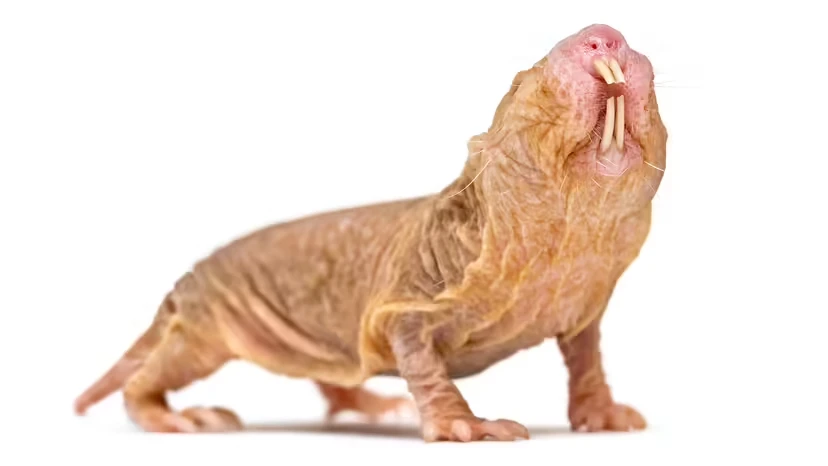Short take: The naked mole rat (Heterocephalus glaber) is a hairless, wrinkly, long-lived rodent from East Africa that lives like ants: one queen, a few breeders, and many workers in sprawling underground cities. It shrugs off low oxygen, feels little pain, and can live up to ~30 years—astonishing for a small mammal.

Size & build: 3–4 in (8–10 cm) long, a few ounces in weight; tubular body, short limbs, tiny eyes.
Skin & “hair”: Mostly hairless with pink-to-yellow, deeply wrinkled skin; a few whisker-like sensory hairs on the face and body to “feel” tunnel walls.
Teeth as tools: Enormous, forward-projecting incisors that can move independently like mini excavator buckets. They dig with their teeth while keeping soil out of the mouth using sealed lips behind the incisors.
Underground-ready: Sparse insulation prevents overheating in warm burrows; valves in the nose and robust jaw muscles suit a dig-first lifestyle. Vision is poor; whiskers and tactile skin do the navigating.
Where they live: Arid grasslands and savannas of Ethiopia, Kenya, and Somalia.
Why underground: Dry, nutrient-poor surface conditions favor a subterranean life protected from heat and predators.
Burrow architecture: Labyrinthine tunnel networks stretching hundreds of feet, partitioned into:
Nest chambers (for the queen and pups)
Larders (food stores)
Toilets (waste rooms to keep nests clean)
Highways (main tunnels) and foraging spurs (to reach tubers)
Diet: Strict herbivores specializing in underground tubers and roots.
Sustainable grazing: They often nibble a tuber without killing it, allowing the plant to regrow—a renewable pantry.
Water budget: Low metabolic rate and water extracted from plants mean they rarely (if ever) drink liquid water.
Naked mole rats are one of the few eusocial mammals—more akin to ants and bees than to other rodents.
Castes & roles:
Queen: The sole breeding female, physically elongated compared to workers.
Breeding males: A small cadre that mates with the queen.
Workers: The majority—small workers dig and forage; larger workers (“soldiers”) defend the colony.
Cooperation first: Food sharing, communal care of pups, and coordinated digging/defense are the rule.
Hierarchy & stability: Chemical cues and behavior keep workers non-reproductive. If the queen dies, intense competition can occur until a new queen emerges.
Litter size: Typically 10–30 pups per litter. Workers act as alloparents—cleaning, warming, and feeding pups.
Development: Young quickly transition to colony tasks: tunneling, food transport, defense.
Lifespan: Up to ~30 years in captivity—exceptional for a mouse-sized mammal (most similar-sized rodents live 2–4 years). Workers generally remain non-reproductive for life unless social upheaval opens a breeding slot.
Low-oxygen champs: They tolerate hypoxic and even hypercapnic (high CO₂) burrow air far better than other mammals.
Pain quirks: Blunted sensitivity to certain pain types (e.g., acid, capsaicin), useful in high-CO₂, acrid environments.
Cancer resistance: Remarkably low cancer incidence for their size and age—an active area of biomedical research.
Thermoregulation: Less efficient at keeping a stable body temperature; they rely on social thermoregulation (piling together) and choosing warmer/ cooler tunnels.
One species, many populations: Heterocephalus glaber shows geographic genetic differences across East Africa that may reflect local adaptation (sometimes discussed as potential subspecies).
Not all “mole rats” are naked: Several African mole-rat species exist; naked mole rats stand out for eusociality and extreme physiology.
Current outlook: Not listed as endangered; populations appear stable due to remote ranges and low hunting pressure.
Potential risks: Habitat alteration, agriculture, and climate shifts that change soil moisture or plant availability could impact colonies.
Why scientists care: Insights into aging, cancer biology, pain pathways, hypoxia tolerance, and social evolution make them a high-value research model.
Are naked mole rats blind?
Not completely, but vision is poor; they rely mostly on touch and smell.
Do they drink water?
Rarely. Plant moisture plus a low metabolic rate usually suffices.
Can any worker become a breeder?
Yes—if the queen dies or is ousted, some workers undergo behavioral and physiological changes to compete for breeding status.
Why do they live so long?
Multiple factors likely contribute: slow metabolism, protected lifestyle, robust cellular defenses, and unique genetics—an active research frontier.
The naked mole rat rewrites mammal rules: it’s a tiny, nearly hairless rodent that lives in ant-like societies, thrives in stale, low-oxygen tunnels, shrugs off certain kinds of pain, and reaches decades-long lifespans. Equal parts bizarre and brilliant, it’s one of nature’s most illuminating oddballs.
animal tags: naked mole rat
We created this article in conjunction with AI technology, then made sure it was fact-checked and edited by a Animals Top editor.